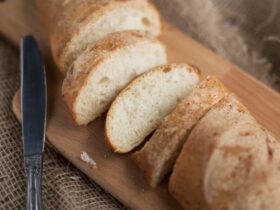If you have ever spent time and effort preparing dough for bread, only to have it disappointingly refuse to rise, you know how frustrating it can be.
One of the most common reasons why dough may not rise is that it was not prepared correctly. This can include using the wrong amount of yeast, not activating the yeast properly, or using water that is too hot or cold. Additionally, the dough may not be rising if it is not being kept in a warm enough environment for the yeast to thrive. Finally, the dough may not rise if it has been kneaded too much, or not enough.
In this article, we will delve into the distinct reasons why your dough fails to rise and offer suggestions for troubleshooting and resolving the issue. Let’s get started and figure out why your dough isn’t rising!
5 Common Reasons why your Dough may not be Rising

- Using expired or inactive yeast. As mentioned previously, yeast is a living organism and can lose its ability to perform over time. It is important to check the expiration date on the yeast package and use the “proofing” method to test its freshness before using it in your dough.
- Not using enough yeast. If you do not use enough yeast in your dough, it may not have enough of the microorganisms needed to cause the dough to rise. Be sure to measure the yeast accurately and follow the recipe’s guidelines for the proper amount of yeast to use.
- Using water that is too hot or cold. Water that is too hot can kill the yeast, while water that is too cold can inhibit its growth. It is important to apply water at the proper temperature, which is typically between 110°F and 115°F. At these temperatures, the water will activate the yeast cause the dough to rise.
- Over-kneading the dough. While kneading the dough helps to develop the gluten, over-kneading can lead to a tough, dense dough that will not rise properly. Be sure to knead the dough just until it becomes smooth and elastic. Any longer and the dough will become too tough to rise.
- Not allowing the dough to rise long enough. The dough needs time to rise, usually in a warm and draft-free place. Be sure to allow the dough to rise for the appropriate amount of time as specified in the recipe.
These factors can all prevent the yeast from activating and doing its job, which is to produce carbon dioxide gas that helps the dough rise.
The Importance of Getting the Amount of Yeast Right

Using the right amount of yeast is crucial for ensuring that your dough rises properly. Several types of yeast are better suited for different types of dough. So, it is important to make sure you are using the right kind for your recipe.
For example, active dry yeast is a viable choice for most bread doughs, while instant yeast is a faster-acting option. Instant yeast can be used in place of active dry yeast in many recipes.
It is also important to measure the yeast carefully. Using too little yeast will prevent the dough from rising, while using too much yeast can lead to an over-proofed dough that collapses. It is also a good idea to stick to a recipe so you can avoid this problem.
Checking the Freshness of the Yeast
One reason your dough may not be rising is that you are using expired or inactive yeast. Yeast is a living organism, and over time it can lose its ability to perform, which impacts the dough’s ability to rise.
To check the freshness of your yeast, you can try the “proofing” method: Mix the yeast with a small amount of warm water (around 110°F) and a pinch of sugar. Let the yeast sit for about 10 minutes. If the mixture becomes foamy and bubbly, the yeast is still active and can be used. If the mixture does not change or only becomes slightly foamy, the yeast may not be fresh enough to use. In this case, you will need to purchase fresh yeast to get your dough to rise properly.
The Role of Temperature

Temperature plays a crucial role in the rising process of dough. Yeast becomes active when it is hydrated, typically with water that is between 105 and 115 degrees Fahrenheit. If the water is too hot, it can kill the yeast and prevent the dough from rising. If the water is too cold, the yeast will not activate and the dough will not rise as it should.
In addition to the temperature of the water used to hydrate the yeast, the temperature of the environment in which the dough is rising can also affect its rise. Dough will rise more quickly in warmer environments, while rising may be slower in colder environments. It is important to find a warm, draft-free location for the dough to rise to ensure optimal results.
The Impact of Salt

Salt is an important ingredient in dough as it helps to control the growth of the yeast and enhances the flavor of the final product. However, it is important to use the correct amount of salt in the dough as using too little or too much can impact the dough’s ability to rise.
Too little salt in the dough can cause the yeast to grow out of control, resulting in an over-risen and unstable dough. Using too much salt can inhibit the yeast’s growth, resulting in a dough that does not rise. It is important to follow salt measurements specified in a recipe or to use the correct amount of salt for the type of product you are making.
For example, bread dough should contain between 1 and 2 teaspoons of salt per cup of flour. This can vary depending on the type of bread being made and personal preference. Using the right amount of salt in the dough will help to ensure a well-risen final product.
Tips for Successfully Getting your Dough to Rise
Check out the following tips so you can help ensure that your dough rises successfully and results in a delicious final product
- Check the expiration date: Make sure to check the expiration date on your yeast and choose a brand of yeast that you know is reliable.
- Cover the dough: Covering the bowl with plastic wrap or a damp towel will help keep the dough moist.
- Use the thermometer: It can be helpful to ensure the water is at the proper temperature.
- Add sugar or honey: Yeast feeds on sugar, so adding a little to the dough can give it a nice lift.
- Avoid placing the dough in a drafty or cold locations as this can slow or halt the rising process.
- Be patient: The rising process takes time, so be sure to allow the dough to rise for the time specified in the recipe or until the dough has doubled in size.
- Punch down the dough: After the first rise, punch the dough down and let it rise again. This will develop the gluten and help the dough rise higher.
Final Words
There are several factors that can impact the success of dough rising. This includes the age and activity of the yeast, the temperature of the water and environment, and the amount of salt used in the dough. By paying attention to these details and following the tips provided in this article, you can help ensure that your dough successfully rises every time. As always, thanks for reading and be sure to keep your kitchen hot and salty!










